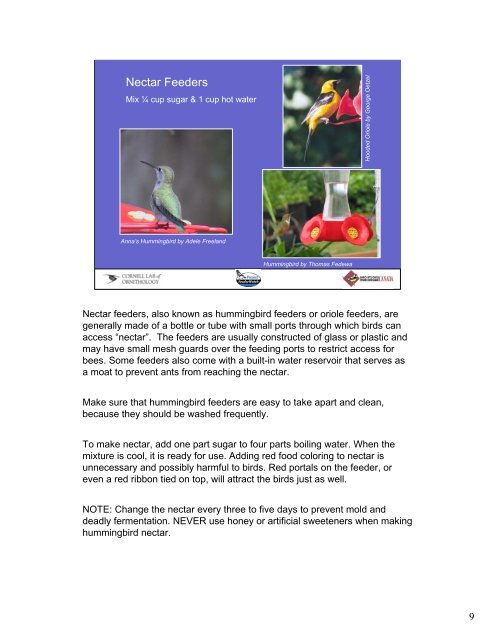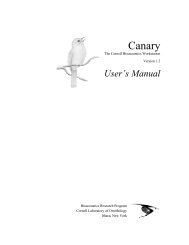Backyard Bird Feeding - Birds - Cornell Lab of Ornithology
Backyard Bird Feeding - Birds - Cornell Lab of Ornithology
Backyard Bird Feeding - Birds - Cornell Lab of Ornithology
- No tags were found...
You also want an ePaper? Increase the reach of your titles
YUMPU automatically turns print PDFs into web optimized ePapers that Google loves.
Nectar FeedersMix ¼ cup sugar & 1 cup hot waterHooded Oriole by George OetzelAnna’s Hummingbird by Adele FreelandHummingbird by Thomas FedewaNectar feeders, also known as hummingbird feeders or oriole feeders, aregenerally made <strong>of</strong> a bottle or tube with small ports through which birds canaccess “nectar”. The feeders are usually constructed <strong>of</strong> glass or plastic andmay have small mesh guards over the feeding ports to restrict access forbees. Some feeders also come with a built-in water reservoir that serves asa moat to prevent ants from reaching the nectar.Make sure that hummingbird feeders are easy to take apart and clean,because they should be washed frequently.To make nectar, add one part sugar to four parts boiling water. When themixture is cool, it is ready for use. Adding red food coloring to nectar isunnecessary and possibly harmful to birds. Red portals on the feeder, oreven a red ribbon tied on top, will attract the birds just as well.NOTE: Change the nectar every three to five days to prevent mold anddeadly fermentation. NEVER use honey or artificial sweeteners when makinghummingbird nectar.9
















